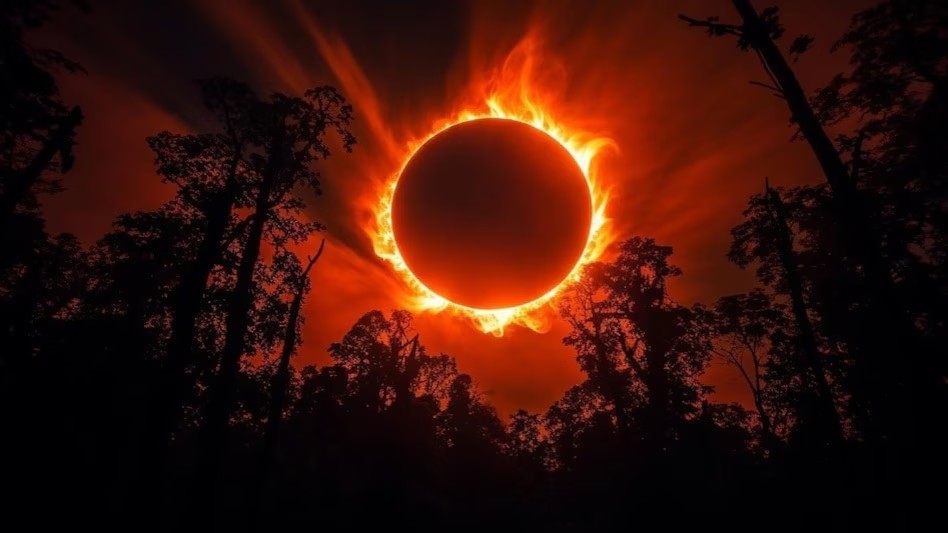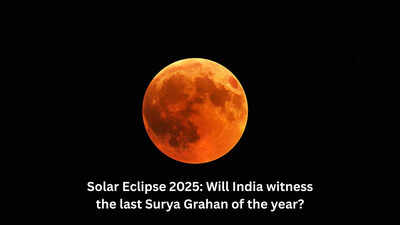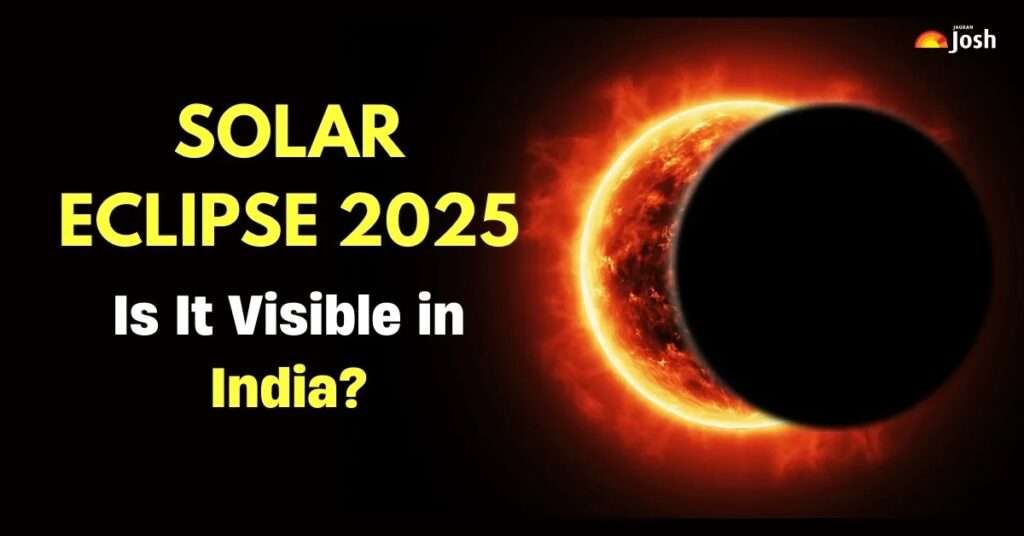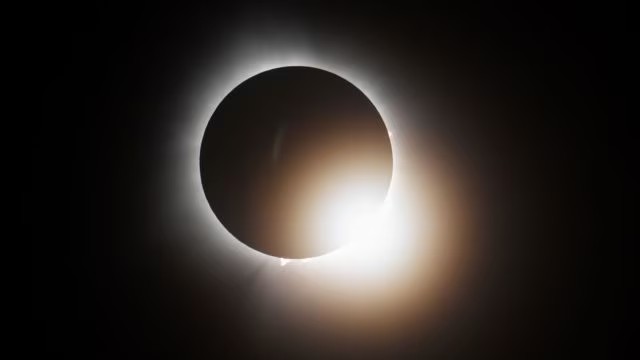Surya Grahan 2025: When will the year’s last solar eclipse occur? Find out if it will be visible in India
The last solar eclipse of 2025 will be a partial solar eclipse occurring on Sunday, September 21. This eclipse will not be visible in India because it will take place during the night according to Indian Standard Time.
The last solar eclipse of 2022 occurred on October 25, 2022, and it was a partial solar eclipse visible in most parts of India. The eclipse was seen in cities like Delhi, Mumbai, and Chennai, beginning in the afternoon before sunset and ending after the sun had set in some locations.
When it happened:
- Date: October 25, 2022.
- Type: Partial Solar Eclipse.
Visibility in India:
- Yes, it was visible in India.
- The eclipse was seen in most Indian cities.
- The viewing times varied by city, with the eclipse beginning before sunset and progressing into the evening.
Key aspects:
- During a partial solar eclipse, the Moon only covers a portion of the Sun.
- The maximum obscuration (coverage) in India was between 40% and 50% in the northwestern parts of the country.
The second and final lunar eclipse of the year occurred on September 7th, and now the final solar eclipse of the year is scheduled for September 21st. According to astrologers, there will be two solar eclipses in 15 days Surya Grahan 2025

Few days back, people have witnessed Total Lunar Eclipse or Blood Moon and now it is the time to see the partial Solar Eclipse on September 21, 2025. This eclipse is the year’s fourth and last. When the Moon partially blocks the solar disk as it moves between the Sun and Earth known as Partial Solar Eclipse. Let’s know more details about this Surya Grahan.
When is Solar Eclipse in September 2025?
On September 21, 2025, there will be the final solar eclipse of the year. Up to 85% of the Sun will be obscured in some places by the Moon during the partial eclipse. The eclipse begins at 10:59 PM IST, peaks at 1:11 AM IST on September 22, and concludes at 3:23 AM IST.
India Will see this Partial Solar Eclipse?
No, Unfortunately, Indian skywatcher’s won’t be able to witness this Surya Grahan. The Sun will have already set in India during this period. Skywatchers here will therefore be unable to witness the celestial display. The Southern Hemisphere will be able to witness the spectacle, especially over the Pacific islands, Antarctica, New Zealand, and eastern Australia. People are advised not to miss this Solar Eclipse and Indian skywatchers can also follow live global broadcasts and photographs shared by observatories in the Southern Hemisphere.
The most striking views will be seen by viewers in Australia and New Zealand. The Moon will block out the majority of the Sun in some Antarctic locations. The sky will also partially darken over island settlements spread across vast expanses of the Pacific Ocean. India, Europe, Africa, and the Americas, on the other hand, will not witness this eclipse at all.
When will next Solar Eclipse be visible in India?
The Indian skywatchers will witnesses the next Solar Eclipse on August 2, 2027. On that day, a partial solar eclipse will occur over the country in the late afternoon and early evening. Calendars will find a rare occurrence of interest as the Sun is partially covered behind the Moon.
What is Partial Solar Eclipse 2025?
Because the Sun, Moon, and Earth are not exactly aligned, a partial solar eclipse occurs when the Moon just covers a portion of the Sun. This will occur this weekend in the South Pacific.


A solar eclipse, also known as Surya Grahan, is set to occur on September 21, 2025. This will be the last solar eclipse of the year. It will be a partial eclipse, which means the Moon will cover only a part of the Sun. People in some parts of the world will see a crescent-shaped Sun in the sky. However, this eclipse will not be visible from India. It will mainly be seen in the Southern Hemisphere, including places like Australia, New Zealand, and parts of Antarctica. In India, the eclipse will happen during the night, so skywatchers here will miss out on seeing it live. Still, it remains an important celestial event.
In this article, we’ll take a look at the date and time of the eclipse, where it will be visible, and why it’s special. We’ll also explore some interesting facts about Surya Grahan and its significance.
Surya Grahan in September 2025: Will it be Visible from India?
The Surya Grahan (solar eclipse) on September 21, 2025, will be a partial solar eclipse, meaning the Moon will cover only a portion of the Sun. This celestial event will be visible mainly across the Southern Hemisphere, including regions like Australia, New Zealand, the South Pacific Islands, and parts of Antarctica.
However, for viewers in India, the eclipse will occur late at night, between 11:00 PM and 3:23 AM IST, making it not visible from any part of the country. Since the eclipse happens outside daylight hours in India, skywatchers here will miss the live spectacle.
Solar Eclipse September 2025: When Is It? Date And Time
The partial solar eclipse of September 2025 will occur on Sunday, September 21, 2025. It’s essential to note that, due to time zones, the eclipse will extend into the early morning of Monday, September 22, in specific locations.
Eclipse Times
The eclipse is a partial one, meaning the Moon won’t completely cover the Sun. The entire event will last over four hours. Here are the key times in Coordinated Universal Time (UTC):
- Partial eclipse begins: 17:29 UTC (22:59:43 IST) on September 21
- Maximum eclipse: 19:41 UTC (01:11:59) on September 21
- Partial eclipse ends: 21:53 UTC (03:23:45) on September 21
Visibility and Path
Unlike a total solar eclipse, which has a narrow path of totality, this partial eclipse will be visible over a wider area. It’s best seen from the Southern Hemisphere, primarily in:
- Australia and New Zealand: Viewers will see the eclipse during their early morning hours.
- Antarctica: This location will have the longest viewing period.
- Various Pacific Islands and Oceania nations.
Unfortunately, this eclipse will not be visible from North or South America, Europe, Africa, or most of Asia, including India.
List of Countries to Witness the Solar Eclipse 2025
According to the real-time data, here’s the list of the countries which will be witnessing the Solar Eclipse in September 2025:
| Country/Territory | Eclipse Type | Start of Eclipse | End of Eclipse |
| American Samoa | Partial Solar Eclipse | 06:29 SST | 08:12 SST |
| Antarctica | Partial Solar Eclipse | 04:49 DDUT | 18:53 CLST |
| Australia | Partial Solar Eclipse | 06:13 AEST | 07:36 AEST |
| Cook Islands | Partial Solar Eclipse | 07:32 CKT | 09:41 CKT |
| Fiji | Partial Solar Eclipse | 05:42 FJT | 07:27 FJT |
| French Polynesia | Partial Solar Eclipse | 07:41 TAHT | 10:04 TAHT |
| Kiribati | Partial Solar Eclipse | 06:38 PHOT | 08:56 LINT |
| New Caledonia | Partial Solar Eclipse | 05:24 NCT | 06:27 NCT |
| New Zealand | Partial Solar Eclipse | 05:41 NZST | 08:36 NZST |
| Niue | Partial Solar Eclipse | 06:31 NUT | 08:26 NUT |
| Norfolk Island | Partial Solar Eclipse | 05:37 NFT | 06:43 NFT |
| Samoa | Partial Solar Eclipse | 06:29 WST | 08:09 WST |
| Solomon Islands | Partial Solar Eclipse | 05:34 SBT | 06:00 SBT |
| Tokelau | Partial Solar Eclipse | 06:31 TKT | 07:52 TKT |
| Tonga | Partial Solar Eclipse | 06:30 TOT | 08:33 TOT |
| Tuvalu | Partial Solar Eclipse | 05:50 TVT | 06:52 TVT |
What You Need to Know:
- This partial solar eclipse will occur on Sunday, September 21, 2025. Due to time zone differences, it will continue into the early hours of Monday, September 22, in some locations, such as New Zealand.
- The eclipse will be visible primarily in the Southern Hemisphere, including much of Oceania and Antarctica.
- At its peak, the eclipse will have an obscuration of approximately 72-85% in the most favourable viewing areas, such as southern New Zealand.
- This is a partial solar eclipse, meaning the Moon will only cover a portion of the Sun, and the sky will not go completely dark.
- The event is not visible from North or South America, Europe, Africa, or mos
The final solar eclipse of 2025 is set to occur on Sunday, September 21, extending into the early hours of Monday, September 22 (Indian Standard Time). This will be a partial solar eclipse, where the Moon covers only a portion of the Sun, creating a crescent-shaped solar disc.
🕒 Eclipse Timings (IST):
- Begins: 10:59 PM on September 21
- Peaks: 1:11 AM on September 22
- Ends: 3:23 AM on September 22
🇮🇳 Will it be visible in India?
Unfortunately, no. The eclipse will occur during nighttime hours in India, making it completely invisible from any part of the country. However, astronomy enthusiasts can still catch the event via online live streams and international broadcasts.
🌍 Where will it be visible?
The eclipse will be best viewed in the Southern Hemisphere, especially:
- New Zealand (up to 72% coverage)
- Antarctica (up to 86% coverage)
- South Pacific Islands like Tonga, Fiji, and the Cook Islands
If you’re in India and eager to witness a solar eclipse, mark your calendar for August 2, 2027, when the next one will be visible across much of the country.
The timing of the eclipse is unique, occurring just before the September equinox — a moment that marks the beginning of spring in the Southern Hemisphere and autumn in the Northern Hemisphere.

A solar eclipse happens at least twice a year. It occurs when the celestial bodies are in alignment. (Image: NASA)
The last solar eclipse of 2025 will take place on September 21, just a day before the equinox. While this celestial event won’t be visible in India, skywatchers in Antarctica, the South Pacific, and New Zealand will witness a remarkable partial eclipse, with the moon covering up to 86 per cent of the sun.
Unlike a total eclipse, this will be a deep partial one. The most dramatic views will come from research stations in Antarctica and from southern New Zealand, where the eclipse will coincide with sunrise, producing surreal crescent-shaped dawns. Several Pacific islands will also see the phenomenon, though with smaller portions of the sun obscured.
The timing of the eclipse is unique, occurring just before the September equinox — a moment that marks the beginning of spring in the Southern Hemisphere and autumn in the Northern Hemisphere.
For observers in India and most of South Asia, the eclipse will happen overnight and won’t be visible directly. However, it will be available to watch via online streams. In Indian Standard Time (IST), the event begins at 10.59 pm on September 21, peaks at 1.11 am on September 22, and concludes at 3.23 am. Watching a solar eclipse is an awe-inspiring experience—but it must be done safely to protect your eyes. Here are essential tips to ensure a safe and enjoyable viewing:
🕶️ Use Proper Eye Protection
- Eclipse glasses: Only wear certified solar viewing glasses that meet the ISO 12312-2 international safety standard.
- Avoid regular sunglasses: Even the darkest ones are not safe for eclipse viewing.
- Solar filters for telescopes/binoculars: Attach filters to the front of the lens—not the eyepiece.
📸 Camera Safety
- Use solar filters on cameras, smartphones, and telescopes to prevent lens damage.
- Never look through a camera or telescope without a solar filter—even if you’re wearing eclipse glasses.
🧒 Supervise Children
- Make sure kids understand the importance of using eclipse glasses and never looking directly at the Sun.
🌥️ Pinhole Projection (Indirect Viewing)
- Create a simple pinhole projector using cardboard to project the Sun’s image onto a surface.
- You can also use a colander, tree leaves, or even your fingers to cast crescent-shaped shadows.
⏳ Know the Eclipse Phases
- Partial eclipse: Always use protection.
- Total eclipse (if visible): You can briefly remove glasses only during the few minutes of totality—when the Sun is completely covered. Put them back on immediately as the Sun reappears.
🚫 Never Look Directly at the Sun
- Even a brief glance can cause permanent eye damage (solar retinopathy). Always err on the side of caution.
Would you like help building a DIY eclipse viewer or finding where to buy certified glasses near you?